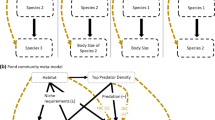Summary
Individual organisms interact directly through behavior, and indirectly through resource consumption and environment modification. The effects of different kinds of interactions on individual growth and reproduction will differ. Freshwater snails may interact directly for food resources and indirectly through substances dissolved in water. I separated the effects of the direct behavioral interaction and indirect interaction through waters using laboratory experiments with freshwater snailsPhysa acuta. Behavioral direct interaction have negative effects on the growth, but indirect interaction through water environments has positive effect on the growth. The importance of distinction of different kinds of interactions were discussed.
Similar content being viewed by others
References
Abrams, P. A. (1987) On classifying interactions between populations.Oecologia 73: 272–281.
Bronmark, C., S. D. Rundle and A. E. Erlandsson (1991) Interaction between freshwater snails and tadpoles: competition and facilitation.Oecologia 87: 8–18.
Brown, K. M. (1982) Resource overlap and competition in pond snails: an experimental analysis.Ecology 63: 412–422.
Damuth, J. and I. L. Heisler (1988) Alternative formulations of multilevel selection.Biol. Phil. 3: 407–430.
Heisler, I. L. and J. Damuth (1987) A method for analyzing selection in hierarachically structured populations.Am. Nat. 130: 582–602.
Kawata, M. and M. Inaba (1992) Individual differences in growth and access to food in the freshwater snail,Physa acuta.J. Ethol. 10: 75–79.
Kawata, M. and H. Ishigami (1992) The growth of juvenile snails in water conditioned by snails of a different species.Oecologia 91: 245–248.
Krebs, J. R. and N. B. Davies (1991)Behavioral Ecology: An Evolutionary Approach. Blackwell, Oxford.
Lam, P. K. S. and P. Calow (1988) Differences in the shell shape ofLymnaea peregra (Müller) (Gastropoda: Pulmonata) from lotic and lentic habitats: environmental or genetic variance?J. Moll. Stud. 54: 197–207.
Lomnicki, A. (1988)Population Ecology of Individuals. Princeton University Press, Princeton.
Lotoka, A. J. (1932) The growth of mixed populations: two species competing for a common food supply.J. Washington. Acad. Sci. 22: 461–469.
May, R. (1977)Theoretical Ecology: Principles and Applications. Saunders, Philadelphia.
McCormick, P. V. and R. J. Stevenson (1991) Grazer control of nutrient availability in the periphyton.Oecologia 86: 287–291.
McMahon, R. F. (1983) Physiological ecology of freshwater pulmonates. 359–430. In W. D. Russell-Haunter (ed.)The Mollusca. Academic Press, New York.
Odum, E. P. (1971)Fundamentals of Ecology, 3rd ed. Saunders, Philadelphia.
Osenberg, C. W. (1989) Resource limitation, competition and the influence of life history in a freshwater snail community.Oecologia 79: 512–519.
Rice, W. R. (1989) Analyzing tables of statistical tests.Evolution 43: 223–225.
Ricklefs, R. E. (1990)Ecology, 3rd ed W. H. Freeman, New York.
Roughgarden, J. (1979)Theory of Population Genetics and Evolutionary Ecology: An Introduction. Macmillan, New York.
Sokal, R. R. and F. J. Rohlf (1981)Biometory. 2nd ed. Freeman, San Francisco.
Thomas, J. D. (1982) Chemical ecology of the snail hosts of schistosomiasis: snail-snail and snail-plant interactions.Malacologia 22: 81–91.
Thomas, J. D., G. J. Goldsworthy and R. H. Aram (1975) Studies on the chemical ecology of snails: The effect of chemical conditioning by adult snails on the growth of juvenile snails.J. Anim. Ecol. 44: 1–27.
Thomas, J. D. and R. H. Aram (1974) The chemical ecology ofBiomphalaria glabrata (Say), the effects of media homotypically conditioned by adult snails on the growth of juveniles.J. Exp. Zool. 190: 329–339.
Thomas, J. D. and M. Behjamin (1974) The effects of population density on growth and reproduction ofBiomphalaria glabrata (Say) (Gasteropoda: Pulmonata).J. Anim. Ecol. 43: 31–50.
Author information
Authors and Affiliations
Rights and permissions
About this article
Cite this article
Kawata, M. Relative importance of direct and indirect interaction among individual snails. Res Popul Ecol 35, 69–77 (1993). https://doi.org/10.1007/BF02515646
Issue Date:
DOI: https://doi.org/10.1007/BF02515646




